What is transition offense in basketball
Transition offense comprises unique fast break basketball offensive strategies in which the main objective is to score points quickly and efficiently, particularly when a team converts from defense to offense.
In other words, when the opposing team changes from being on offense formerly to switching into defense currently, there could be certain instances in which that same opposing team may not have enough time to adequately protect their own basket or implement sufficient defensive formations.
If that were to occur, then the transition offense can take advantage of those potential defensive deficiencies.
What are the common strategies of transition offense
The common strategies of transition offense consists of different types of fast break systems known as the primary break, the secondary break, and the numbered fast break.
Primary break
The primary break is a basketball offensive strategy that is also the initial fast break phase of transition offense and its general purpose is to create quick scoring opportunities against a defensive team that is outnumbered, usually within the first two or three seconds after gaining possession of the ball.
One notable advantage of the primary break within transition offense is that it is generally one of the easiest procedures for creating scoring opportunities, particularly near the basket before the defensive team has a chance to respond effectively.
Conversely, one noteworthy weakness of the primary break (and transition offense in general) is that it could lead to low quality shot attempts, not shot attempts at all, or unnecessary turnovers, particularly if the offensive players are going too fast, lack communication, and/or they have insufficient team chemistry.
Typical situations in which the primary break could be executed are when Team A (one specific team currently on offense) misses a shot, makes a shot, or commits a live-ball turnover during their own offensive possession.
Afterwards, Team B (one particular team currently on defense) gains possession of the ball. At that exact moment, Team B transitions into the new offensive team (i.e. transition offense) and then, Team B could potentially execute the primary break, generally within the first two or three seconds after gaining possession of the ball.
Secondary break
The secondary break is a basketball offensive strategy as well as the alternative fast break phase of transition offense which consists of scoring options typically around the basket or near the perimeter areas directly after the defensive team stops the initial primary fast break action.
The primary strengths of the secondary break is that it could be utilized to take advantage of defensive mismatches, poor defensive closeouts, or a general lack of proper defensive awareness.
Numbered fast break
The numbered fast break is a basketball offensive strategy in which each of the five players, during transition offense, are assigned specific numbers and given special roles related to those numbers with the main objective of creating quick scoring opportunities near the basket or near the perimeter areas of the court.
The numbered fast break features a predetermined plan of offensive scoring options during transition offense as opposed to the improvisation between the offensive players as within a standard or primary fast break.
In terms of the typical player roles/responsibilities within the numbered fast break, player 1 is the point guard which dribbles the ball down the court quickly, preferably near a slot area and then passes the ball to other teammates that are open.
Player 2 is the shooting guard that runs very wide down the sideline to the corner ready to receive the ball for a possible jump shot opportunity, especially from three-point range.
Player 3 is the small forward that also runs very wide down the sideline (on the opposite side of player 2) to the corner. However, player 3 also has the option to cut in towards the basket, generally near the low post block, ready to receive the ball for a possible scoring opportunity near the basket.
Player 4 is the power forward which generally runs parallel to player 1 in the opposite slot towards the three-point line. However, player 4 also has the option to first, run to the rim, and then second, cut through to the strong side low post block one the same side of the court as player 1.
Player 5 is the center which grabs the rebound if the opposing team misses a shot attempt quickly gets the ball out of the net if the opposing team makes a shot. Following that, the center will either inbound the ball (on a make) or simply give it (on a miss) to the point guard.
From there, the center will usually trail behind all of the other players and eventually settle near the low post block on ball side or remain adjacent to the perimeter, which generally depends on the action of player 4.
Affiliate Disclosure: I may earn a commission on qualifying purchases made through the links below.
What are examples of scoring options within transition offense
Example 1 – Part 1
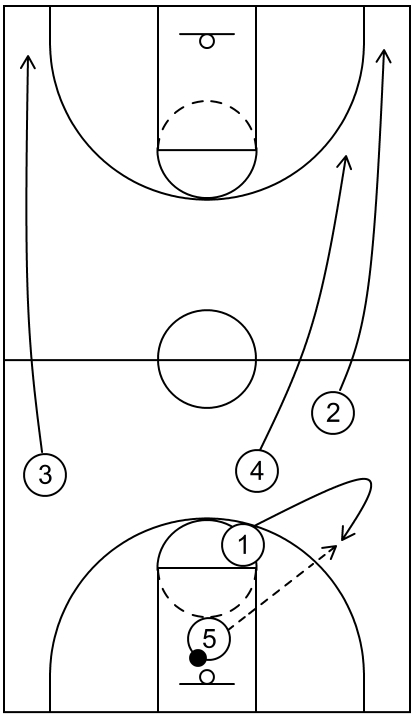
This is an example of scoring options within transition offense that could flow from primary break to secondary break. It is derived from Accelerating Your Transition Offense by Archie Miller.
Also, for this sequence, it is assumed that the opposing team missed a shot attempt which was then rebounded by one of the current offensive players near the basket.
Furthermore, this demonstration features one offensive player breaking out on one side of the court and two additional players breaking on the other side.
Coach Miller refers to that transition offense concept as a single side, pair side because one side of the court has a single offensive player while the other side has a pair of offensive players.
To begin, 5 gathers the rebound after the missed shot and when that occurs, 1 pops out and pivots with their backside facing the sideline to receive the ball.
Additionally, at the same time, 3 sprints down the court to the left corner which is the single side.
Furthermore, on the pair side, 2 is ahead of 4 so this means that 2 should sprint to the right side corner while 4 sprints to the right side wing area.
Example 1 – Part 2
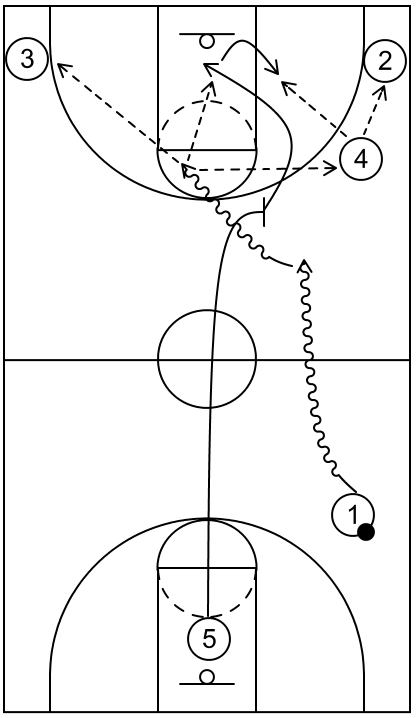
Next, 1 begins to dribble down the court near the extended right slot area and as that occurs, 5 who is also the rim runner, will sprint ahead of the ball and set a drag screen near the right side slot.
Afterwards, 1 will dribbles towards the middle of the court, preferably near the nail area, while 5 rolls to the rim after setting the drag screen.
From that point, 5 could receive the ball from 1 and score at the basket with a layup or dunk if that is open. Alternatively, 1 could take the mid-range or three-point jump shot if that is open.
In addition to that, 3 could receive a kick pass from 1 and take the three-point shot if that is open as well.
Moreover, 4 could receive the ball from 1 and take a three-pointer as well if that is open or 2 could receive the ball from 4 for another possible three-point opportunity.
Furthermore, when 4 receives the ball, 5 could follow that pass and establish position near the low post block on the strong side of the court.
After that, 5 could receive the ball from 4 and attempt to score near the basket with a low post move.
Example 2 – Part 1
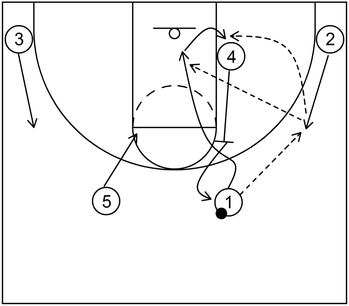
This is an example of scoring options within secondary break, particularly for the point guard, based on offensive actions within Transition Offense and Quick Hitters by Gail Goestenkors.
To begin, 2 lifts to the right side wing while 3 lifts up to the left side wing. Also, at the same time, 5 cuts to the left side high post elbow area.
Following that, 2 receives the ball from 1 and after that, 1 cuts to the basket via a UCLA screen set by 4.
Afterwards, 1 could receive the ball again from 2 and score at the basket. If 1 is not open on the initial basket cut, then 1 could fill the right side low post block.
Also, 4 could pop out to fill the right slot area after setting the UCLA screen. Additionally, if 1 has low post abilities, then 1 could receive the ball from 2 and score via a low post move as well.
Example 2 – Part 2
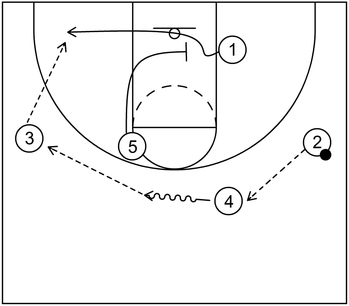
Next, assuming 1 did not receive the ball at all, 4 could receive it instead from 2. From there, 4 could begin to dribble towards the left slot area and then 3 could receive the ball from 4.
Also, at the same time as the dribble action occurs, 1 could cut to the short corner via the cross screen set by 5. From there, 1 could receive the ball from 3 and take the mid-range jump shot if open.
What is an example of a transition offense basketball drill
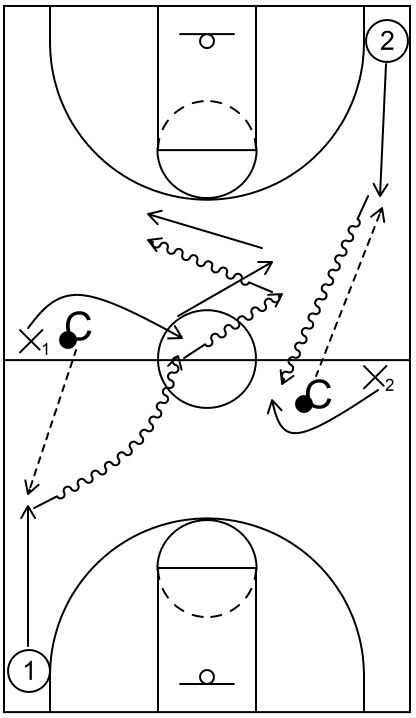
This is an example of a 1-on-1 basketball drill derived from Transition Offense by Nate Oats.
Offensively, the drill focuses on developing dribbling skills while staying aggressive against on-ball pressure without turning the ball over during a transition attack downhill towards the basket.
Defensively, the drill emphasizes stopping the ball during transition as well as the proper stance and lateral sliding footwork techniques, which is generally common for man to man defense in addition to basketball defense comprehensively.
Additionally, the drill can work on player conditioning and help both offensive and defensive players become acclimated to full court basketball.
To start the drill, two offensive players (indicated as 1 and 2) can fill opposite corners of the court. At the same time, two defensive players (indicated as X1 and X2) could stand near the sidelines on the opposite side of the offensive player that they are assigned to.
However, as a side note, it is also possible to execute the drill with only one offensive player and one defensive player to create more spacing on the court. This could potentially make it a little easier to dribble or defend for the players.
Additionally, each defender will initially turn their back away from the offensive player that they are assigned to guard.
For example, X1 will be assigned to guard against 1 on offense and X2 will be assigned to defend against 2.
Therefore, X1 and X2 would stand on the opposite side of the court. That is to say, from the perspective of the offensive players (1 and 2), X1 and X2 will be in the frontcourt.
Furthermore, X1 and X2 will initially be turned facing away from 1 and 2 respectively. In other words, X1 and X2 will initially look towards the basket that 1 and 2 will seek to attack and score.
Moreover, the letter C adjacent to X1 and X2 are the coaches which possess the basketball at that current time.
Additionally, those coaches will face the direction of 1 and 2 as opposed to X1 and X2. Also, those coaches will be about a step below the defenders. This allows the defenders to see the ball in the hands of the coach for the time being.
Next, 1 and 2 could begin to sprint down the sideline and afterwards, 1 and 2 could receive the ball from the coach upon reaching the extended wing area.
From that point, as soon as 1 and 2 receive the ball, they can immediately attempt to dribble drive towards the basket.
At the same time, when the coach releases the ball, X1 and X2 could quickly pivot turn, locate the offensive player with the ball and try to stay in front of that same player at all times.
Afterwards, the offensive players with the ball could try to score at the basket with a layup or create potential separation near the perimeter for a possible mid-range or three-point jump shot.
In addition to that, once the players complete the drill (after the offensive players attempts a field goal), the players could switch from offense to defense and vice-versa.